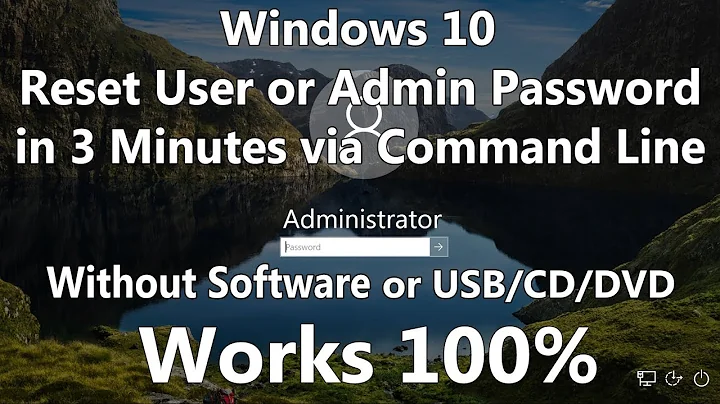Recovering a Windows 10 password when the partition is read-only
Solution 1
Start booting Windows and press F8 during the boot process. Select to discard hibernation data and start Windows normally, then shut it down. That should remove hibernation data and make the partition read-write again.
As a last resort, boot Windows till the password prompt, wait for the HDD to settle down then switch the laptop off with the power button.
Then boot into Debian and try the chntpw trick once more.
Solution 2
There is an easy fix for this problem.
Boot Windows, then click on the screen to access the login window.
In the lower right corner, click the Power icon, then click restart. No hibernation data is written by Windows when restarted, only when shut down.
Boot into Linux and go ahead with clearing your Windows password.
Once you're able to log into Windows, disable Fast Startup so you won't run into this problem in the future. See https://www.windowscentral.com/how-disable-windows-10-fast-startup for how-to details.
By the way, as mentioned in the article, you will probably have to disable Fast Startup again after each Windows "edition" update.
Solution 3
The solution for me was what Egan Johnson posted in his answer (I do not have reputation to upvote or comment, so adding separate answer here).
I was in the same situation as the original poster:
- Windows 10 shut down with a hiberfile, so Linux live distro can not mount NTFS with read write permissions, and therefore
chntpwcan not work. - With no working login to to Windows to change the Fast Boot option, not possible to get a clean shutdown without hiberfile
In addition the F8 option in the accepted answer was disabled. To enable it, you need to log in change it, so not possible without login.
What solved it for me was following Egan Johnson's answer and this link How to Fully Shutdown Windows 10 Instead of Hibernating It.
Holding down SHIFT while clicking Shutdown from the login screen, I was able to perform a clean shut down off Windows from the login screen. Next boot with Linux live was able to mount the disk with read write permissions.
Solution 4
There is another option. Before you ran chntpw in Debian, you had to mount the drive with a command like sudo ntfs-3g /dev/sda3 /media/sda3. (That assumes that you already created /media/sda3.) If you had used the remove_hiberfile option, such as sudo ntfs-3g -o remove_hiberfile /dev/sda3 /media/sda3, then ntfs-3g would have deleted the Windows hibernation file hiberfil.sys for you, which would have solved your problem.
Please note that using an external program to delete the Windows hibernation file is dangerous, because any data saved only to the hibernation file will be lost. This procedure is only to be done as a last resort.
Related videos on Youtube
Sam
Updated on September 18, 2022Comments
-
Sam almost 2 years
On my new laptop I entered a new password for my account the first time I booted Windows. I no longer remember this password.
The account was just a local account and not a Microsoft account, so I can't recover the password that way.
I am a linux user and have installed Debian alongside Windows. I tried using the 'chntpw' software to change/remove the account password, but when I run the program in the correct folder I get the following error:
root@sam:/media/sda3/Windows/System32/config# chntpw -i SAM chntpw version 1.00 140201, (c) Petter N Hagen openHive(SAM) failed: Read-only file system, trying read-only openHive(): read error: : Read-only file system chntpw: Unable to open/read a hive, exiting..I did a bit of googling and found out that Windows 10 has a half-hibernate feature that allows it to boot faster, but requires the partition to be read-only even when Windows has shut down. There is a way to turn this off in the settings, but I can't access the settings as I can't log in!
Is there a way to use chntpw while the partition is locked, or alternatively a way of shutting down Windows so that I can write to the partition?
-
Ramhound over 8 yearsThe author is unable to boot into Windows, in order to disable hibernation, because he doesn't know the password to what I presume is the only user account enabled. So simply discarding the hibernation data would be enough in this case, to solve the problem that the drive is locked, because of the hibernation file.
-
 Dmitry Grigoryev over 8 yearsF8 menu is not password-protected AFAIK.
Dmitry Grigoryev over 8 yearsF8 menu is not password-protected AFAIK. -
Ramhound over 8 yearsIf the user starts Windows 10 normally then shuts Windows down, a new hibernation file will be created, because he wasn't able to log into the user in order to disable hibernation since that is the default behavior.
-
 Dmitry Grigoryev over 8 yearsDo you think the power button trick might work?
Dmitry Grigoryev over 8 yearsDo you think the power button trick might work? -
Ramhound over 8 yearsI think enabling the Administrator user and disabling hibernation or simply doing this and booting into his other operating system would be a better solution. A hard shutdown seems like an odd solution to a problem easily worked around.
-
Sam over 8 yearsThanks for this answer. I'm not sure why my question was downvoted but this solved my problem and will help other people in the same situation.
-
 Yosi Azwan about 5 yearsthnks.work 4 me.
Yosi Azwan about 5 yearsthnks.work 4 me. -
 Andrew Hale over 4 yearsThis worked for me as well. Great tip.
Andrew Hale over 4 yearsThis worked for me as well. Great tip. -
 Twisty almost 4 yearsThis helped with ny Father's HP with Win 10. He passed recently and didn't share the password with anyone. Shift + Restart was helpful for getting into Safe Mode.
Twisty almost 4 yearsThis helped with ny Father's HP with Win 10. He passed recently and didn't share the password with anyone. Shift + Restart was helpful for getting into Safe Mode. -
 Pedro Antônio about 3 years"No hibernation data is written by Windows when restarted, only when shut down". Thats the point. Works well. Thanks
Pedro Antônio about 3 years"No hibernation data is written by Windows when restarted, only when shut down". Thats the point. Works well. Thanks -
 Arun Prasad E S over 2 yearsThanks. saved me ton of time.
Arun Prasad E S over 2 yearsThanks. saved me ton of time. -
 Admin almost 2 yearsThanks but this doesn't work for me. Any suggestion? (I tried shift + shutdown and turned the swith on and tried ubuntu)
Admin almost 2 yearsThanks but this doesn't work for me. Any suggestion? (I tried shift + shutdown and turned the swith on and tried ubuntu)





